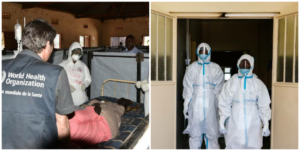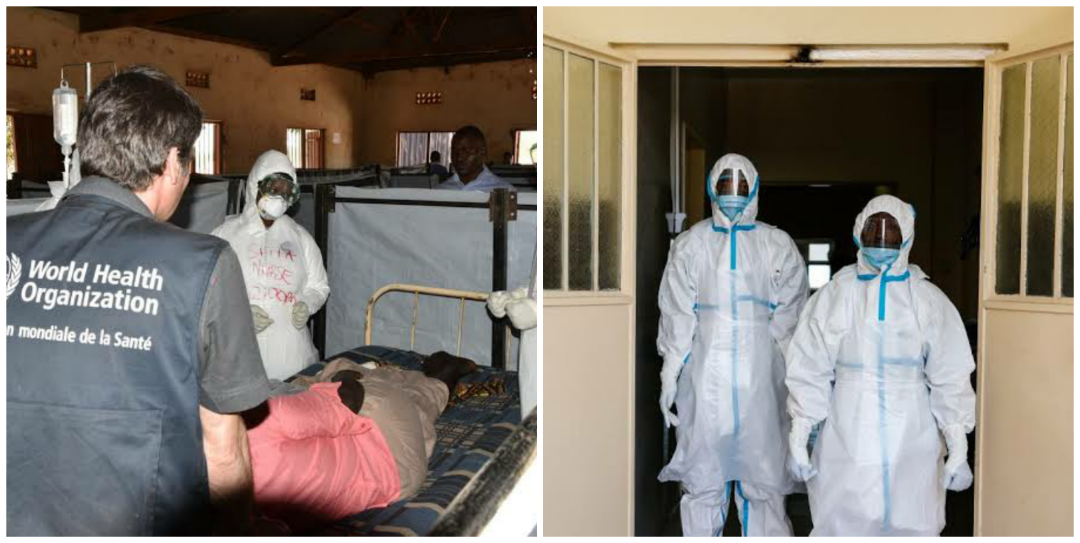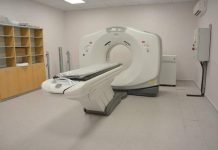A multifaceted Emergency Response Plan to disease outbreaks..
Towards a multifaceted and comprehensive response to disease outbreaks: a case for firing on all cylinders
“No one can whistle a symphony. It takes a whole orchestra to play it.” ~ H.E. Luccock
A disease outbreak refers to an increase, often sudden, in the number of cases of a disease above what is normally expected in a specific time, place and population. Hence, an effective disease outbreak response requires an enormous amount of resources above and beyond those that are used in routine healthcare.
Moreover, infectious disease outbreaks, particularly those of novel pathogens, are often complex and challenging, as evident from the current coronavirus disease 2019 (COVID‐19) pandemic.

As the novel coronavirus continues to spread globally and within national borders, efforts are being accelerated to identify the most effective preventive, therapeutic, as well as broader public health and socioeconomic measures to mitigate its multi-dimensional impacts. A comprehensive emergency response Plan to disease outbreaks will comprise many elements that should be harmoniously coordinated.
In the following paragraphs, I highlight the key elements to a multifaceted and comprehensive approach to disease outbreak response, with specific references to the current pandemic and some notable disease outbreaks in the past.
These key elements are discussed under the following distinct but interrelated themes: initial assessment of the outbreak situation; developing a clear road-map for response; mobilisation of resources; coordination of responders; enforcement of public health measures; strategic risk communication; pragmatic disease surveillance and monitoring; community engagement; and the alleviation of socioeconomic impacts.
Initial assessment:
The first response to an infectious disease outbreak is usually the initial rapid assessment of the situation to gain as much understanding of the causative pathogen and its determinants as possible, while identifying the most-at-risk populations and the most cost-effective means of preventing, treating and palliating the disease. These initial assessments are useful for developing a clear road-map for responding and mitigating the further spread of the outbreak.
Clear road-map for response:
Early insights gained from the initial situation analysis should be utilised to map a comprehensive framework for outbreak response. This requires strong and pragmatic leadership, and should not be an occasion to allow political or ideological considerations to meddle with this highly important priority-setting process.
The road-map developed should clearly establish what needs to be done; by whom, when and where; as well as what resources are required, and how best to mobilise and allocate them. Plans will be specific for different diseases and contexts. For instance, while the universal use of face masks may be a key consideration in an outbreak response framework for respiratory diseases like COVID-19, it will not be the case for diseases like Ebola Viral Disease (EVD).
The response road-map also needs to be evidence-based and dynamic, regularly updated as the outbreak evolves. Furthermore, it should enable the concurrent and risk-adjusted implementation of preventive, therapeutic and wider mitigating interventions, all of which should be seen as collectively important for achieving the best outcomes.
Mobilisation of resources:
An effective response to disease outbreaks requires an enormous amount of resources. At all levels, governments, public health authorities and other key stakeholders have the duty to make available the resources needed, whether for scaling up testing capacity; procuring personal protective equipment (PPE); recruiting additional human resource; funding research of potential vaccines and therapies; building new isolation facilities and hospitals; or distributing financial palliatives.
The current pandemic has clearly shown how inadequate resource mobilisation, manifesting in suboptimal testing capacity, limited bed spaces, ventilator shortages etc., can undermine the response to the COVID-19 pandemic in enormous ways.
Coordination of responders:
Responding to disease epidemics is a daunting task that undoubtedly requires a multi-disciplinary approach. For instance, epidemiologists, environmentalists, veterinarians, ecologists, microbiologists and statisticians are needed for studying and creating new knowledge of the emergence and transmission dynamics of the pathogen; communication experts and journalists are valuable for the dissemination of risk communication and public health messages; and biomedical scientists and engineers are vital for the innovation and design of test kits and critical supplies such as ventilators.
Equally important are frontline health workers, including nurses, pharmacists, clinical laboratory scientists, doctor and many others, who are essential for the timely treatment and clinical management of cases; social workers and community health workers, who are crucial for effective contact-tracing and identification of presumptive cases; immunologists and vaccinologists, whose knowledge and expertise are needed to advance research and development on potentially effective and safe vaccines against the disease; and legal practitioners, who have a vital role in the formulation of legally sound public health and outbreak response policies, consistent with human rights standards.
Other important responders will include psychologists and other mental health practitioners, who are important for addressing the mental health burden of the outbreak; as well as economists, who are needed for planning and implementing measures for alleviating the socioeconomic impacts of the outbreak.
The sheer multiplicity of these responders does not complicate the outbreak response process. However, it demands the establishment of shared goals, clarity of roles, collaboration and effective communication among all stakeholders.
Enforcement of public health precautions:
Precautionary public health measures such as physical distancing and prohibition of public gatherings should be intentional and risk-adjusted; in the sense that the enforcement of these measures should have a clear purpose (not done just because other countries or places are implementing them), they should evolve with time (not static) and should be cautiously eased as soon as the epidemiologically situation allows for such.
When enforcing these measures, it is important to take into account certain practical considerations. Interventions such as school or workplace closure, while having clearly justifiable public benefits in outbreak settings, have their social and economic costs.
Moreover, a public health measure that was effective in one context may be less effective or even counter-productive in another context. Saving lives from a disease outbreak is important, as is safeguarding livelihoods from the harsh socioeconomic consequences of the outbreak. Hence, such mitigation measures need to be context-appropriate and should be implemented in a way that balances their health benefits and socioeconomic costs.
Strategic risk communication and public health education:
These should aim to disseminate information as fast and as clearly as possible, including translation into local languages. Multiple communication channels, including social media platforms like Facebook and WhatsApp should be used to communicate the health risks of the outbreak and the precautions to take. Efforts should be made to ensure a balanced, evidence-based messaging that is neither alarmist nor downplaying the risks of infection, morbidity and mortality of the disease.
Clear messaging should also aim to build public confidence and trust in efforts of public health authorities, while proactively countering misinformation, rumours and hoaxes in a timely and strategic manner.
In addition, an effective communication strategy needs to identify information sources trusted by the public – such as health workers, as well as political, religious and social leaders, including celebrities. These societal appeal and influence of these individuals should be leveraged in reaching out to those who hold them in high esteem.
Alleviation of social and economic impacts:
Disease outbreaks, as evident from the current pandemic have impacts that transcend the health of individuals and communities. They have far-reaching social and economic implications that may result directly from the disease itself or from the socioeconomic interventions implemented in response to the outbreaks. These implications are direr for resource-constrained countries and communities, where outbreaks can easily worsen existing socioeconomic realities.
Therefore, a comprehensive outbreak response must make substantial efforts to avert and alleviate these negative consequences through a careful assessment of the impacts and identifying practical and equitable strategies for addressing such.
The strategies can include measures to assist the poor and vulnerable communities, such as the distribution of food parcels and unemployment grants for those who have lost their jobs as a result of the outbreak. They should be progressively implemented within the financial resource capacity of the country and community, in partnership with non-governmental organisations, the private sector and well-meaning individuals.
Pragmatic disease surveillance and monitoring:
Disease surveillance is the continuous scrutiny of the occurrence of diseases to enable the timely institution of appropriate interventions. It involves the ongoing systematic collection, collation, analysis and interpretation of epidemiological data, as well as the transparent dissemination of the information obtained from such data for prompt public health action.
An optimal testing or diagnostic capacity is essential for effective disease surveillance and monitoring, as are efficient contact tracing and active case finding.
An effective and efficient disease surveillance and monitoring system enables the early detection of cases, while prompting contact tracing and other interventions for mitigating the further spread, morbidity and mortality that may result from an outbreak.
Disease surveillance and monitoring are organised at different levels:
local, national and international; all of which should be consistent and non-contradictory. An important aspect of disease surveillance is the regular and clear dissemination of information through dashboards that are accessible to the general public.
There have been commendable efforts in this regard during the ongoing COVID-19 pandemic, with informative and near real-time dashboards curated by national governments, global health authorities like the World Health Organizations (WHO) and academic institutions like the Johns Hopkins University.
However, the usefulness of the information disseminated will depend on the reliability and completeness of their sources, which can be limited by challenges such as testing capacity limitations, which often lead to under-reporting of the number of cases; as well as constraints with hospital records, which can complicate the tallying of the number of recoveries.
Community engagement during epidemics:
Communities are vital stakeholders in outbreak response. A community is a distinct group of people who share a common purpose of being and a sense of belonging together. A community is not always geographically bound, but may also be defined ideologically, demographically, professionally etc. Within communities, people live in unique social-cultural contexts which may shape their beliefs, perception and behaviour, all of which can influence their perception of the public risks posed by disease outbreaks, while determining whether or not they accept and comply with certain public health advice and precautions. Community engagement is critically important for effectively responding to epidemics.
It serves three main purposes:
Establishing a dialogue between responders and communities; empowering communities and giving them a sense of belonging and agency as important stakeholders in the outbreak response; and building trust through mutual understanding for establishing shared goals and collective efforts against the disease.
Final words
Disease outbreak response is complex and often practically challenging. It is indeed like a symphony. No one can whistle it. Rather, it takes a whole orchestra to play it and achieve the best outcomes. A multifaceted Emergency Response Plan to disease outbreaks is the way to go in stopping deadly infections in their tracks.
By Dr Chuks Nnaji
























